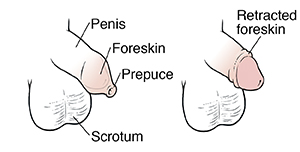When Your Child Has Phimosis
 |
| The unretracted foreskin and prepuce cover the penis. Retraction of the foreskin uncovers the head of the penis. |
Your child has been diagnosed with phimosis. This is a condition in which your child’s foreskin doesn’t move over the head of the penis the way it should. Without treatment, phimosis can cause problems for your child as he grows and matures. Your child’s healthcare provider will talk with you about the best way to treat phimosis.
Understanding phimosis
In uncircumcised boys, the foreskin lies over the head of the penis. It starts to loosen from the head of the penis by age 3. This allows the foreskin to gently slide back (retract) over the head of the penis. In some boys, the tip of the foreskin (prepuce) is very tight, making it hard to retract. This is phimosis.
What causes phimosis?
The exact cause of phimosis is not known. It is most likely to be identified in boys between ages 4 and 7.
How is phimosis diagnosed?
Phimosis is easily diagnosed during an exam. For the exam, the healthcare provider will need to look at and handle your child’s penis. You can help make your child more comfortable by reassuring him that this is OK.
How is phimosis treated?
To treat phimosis, the healthcare provider may advise:
-
Slow, gentle retraction of the foreskin. You will be taught how to do this at home.
-
A prescription steroid cream. The cream helps to promote skin loosening. The healthcare provider will show you how to use it.
-
Removing the foreskin (circumcision). This may be advised if your child’s phimosis is severe.
What are the long-term concerns?
If phimosis is not treated, it can cause problems as your child gets older. The flow of urine from the penis may become blocked. This can make urination messy or difficult. It may also increase the risk for infection because of trapped urine.
It's important to understand that uncircumcised boys may be at greater risk of certain health problems, including balanitis and other infections of the penis. This is because of the buildup of dead cells under the foreskin and the resulting poor hygiene. Uncircumcised boys may also be at greater risk of cancers.
When to call the healthcare provider
Call your child’s healthcare provider right away if your child has any of the following:
-
Foreskin is retracted and won't go back over the tip of the penis (paraphimosis)
-
Bleeding from the foreskin
-
Pain during foreskin retraction
-
Redness or swelling of the penis
-
Any discharge from the foreskin